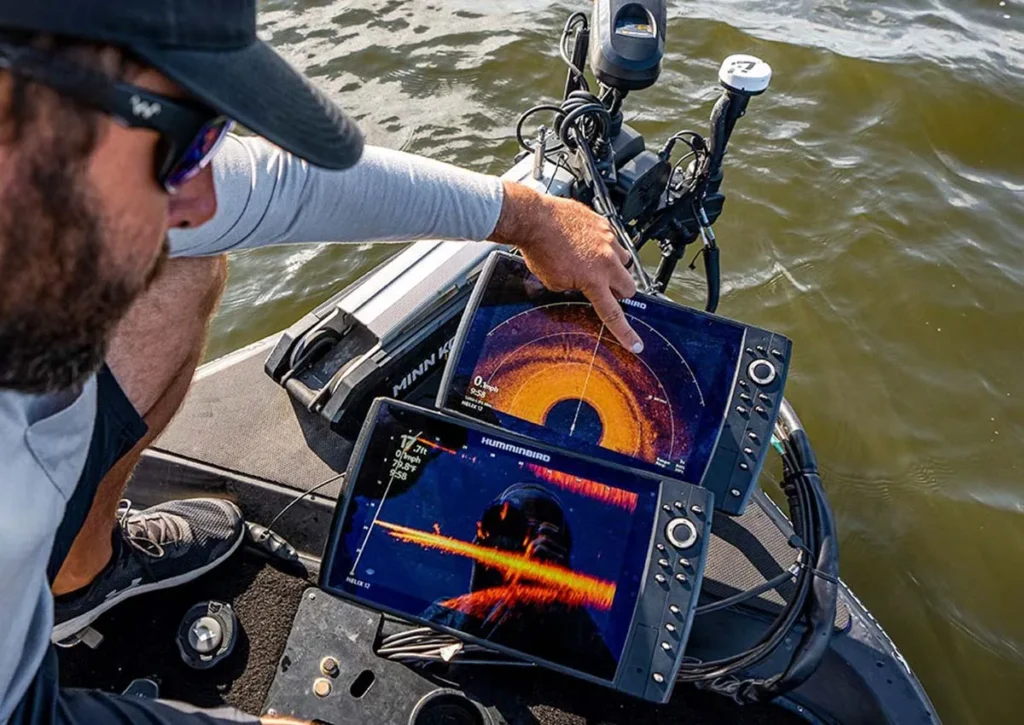CHIRP on a fish finder stands for Compressed High-Intensity Radar Pulse. This advanced technology significantly enhances the ability of anglers to see and understand the underwater world. By emitting a continuous sweep of sonar frequencies, CHIRP provides a more detailed and refined view of the water column, bottom contours, and aquatic life, revolutionizing the style of fishing through improved accuracy and efficiency.
The Basics of CHIRP Technology
Chirp technology represents a leap forward in sonar technology, using a range of frequencies to offer superior resolution and target detection compared to traditional single-frequency sonar.
Understanding How CHIRP Enhances Sonar
CHIRP enhances traditional sonar by transmitting a continuous sweep of frequencies, which results in better target separation and clearer definition. This allows anglers to distinguish between game fish and other underwater structures with greater precision than single-frequency sonar.
The Role of Multiple Frequencies in CHIRP
Multiple frequencies in CHIRP collaborate to create a more complete picture of the underwater environment. CHIRP normally operates within frequency ranges depending on the depths, offering more detail than high chirp in shallow waters and better performance than traditional 2D sonar in depths less than 600 feet.
CHIRP’s Clarity in Structure Views
CHIRP transducers emit a range of frequencies to build an enhanced picture of fish and submerged objects, providing clearer images than standard fish finders operating on single or two frequencies. This range of frequencies is like shooting a burst of light into the depths, illuminating the water in a way that a fish finder operating with a single frequency cannot match.

Advantages of Using CHIRP on Fish Finders
CHIRP’s advanced intensity radar pulse provides unparalleled sonar data clarity, giving anglers an edge in locating and identifying fish beneath the surface.
How CHIRP Leads to More Accurate Fish Identification
With CHIRP technology, anglers can more accurately identify fish species and sizes, thanks to the enhanced resolution and target separation capabilities.
CHIRP Benefits: Why It Matters to Anglers
For anglers, CHIRP’s detailed sonar returns mean improved catch rates and a more enjoyable fishing experience.
Identifying Individual Fish vs Schools
CHIRP technology excels at differentiating between individual fish and schools, providing anglers with critical information to adjust their approach and tactics accordingly.
CHIRP’s Role in Determining Fish Size
CHIRP helps avoid the common mistake anglers make in estimating fish size, as it ensures the fish is in your sonar cone for a longer period, which aids in more accurate size assessment.
Interpreting Sonar Images for Accurate Sizing
Interpreting sonar images with CHIRP provides higher levels of detail, which translates into more precise sizing of the fish being targeted.
Exploring the Underwater Terrain
CHIRP sonar advances the exploration of underwater terrain, offering clarity and insight into the environment where fish thrive.
CHIRP and Bottom Consistency Analysis
CHIRP sonar serves as a reliable indicator of bottom hardness, helping anglers identify areas likely to hold fish.
Gauging Bottom Color and Thickness
The intensity of the sonar return on a CHIRP fish finder can reveal key insights about the bottom composition. A stronger return, often shown in orange, and a soft, lighter return, suggests different bottom types—hard or soft, respectively. This data allows anglers to discern bottom features and thickness, which can affect where fish may be located.
Recognizing 2nd Bottom Returns for Advanced Insight
CHIRP sonar’s advanced capabilities enable anglers to identify 2nd bottom returns, which are echoes from beneath the initial bottom reading. These secondary returns provide additional information about the underwater environment, such as the presence of soft sediments over a harder base, offering a more comprehensive understanding of the aquatic terrain.
The Impact of CHIRP on Locating Key Features
CHIRP technology enhances the ability to locate key underwater features where game fish are likely to be found. Using a medium chirp frequency yields greater detail than high chirp or traditional 2D sonar, especially in depths less than 600 feet, providing critical information for successful angling.
Vegetation, Depressions, and Drop-Offs
CHIRP sonar is invaluable for identifying areas favorite for predator fish, such as vegetation and drop offs. Anglers can use tips for locating drop-offs and points, set a depth alarm for a chosen depth, and rely on the clearest reading to pinpoint shelves or humps using bathymetric maps in boat mode.
Utilizing CHIRP for Enhanced Vegetation Imaging
Medium chirp frequencies provide superior vegetation imaging compared to traditional 2D sonar, particularly in depths less than 600 feet. This allows anglers to navigate through weeds and brush piles, which are often vibrant in color and clearly defined, making them ideal for coarse fish that peruse these areas searching for food.
How Drop-Offs and Points Appear on CHIRP Displays
On CHIRP displays, drop-offs and points are key ambush points for predator fish and appear as significant changes in the contour lines. Anglers can utilize tips for locating drop-offs and points, and set a depth alarm to maintain a chosen depth for the clearest reading of these underwater structures.
Practical Application of CHIRP in Fishing
Implementing CHIRP technology in fishing enhances the angler’s ability to locate and target fish effectively. It provides a detailed view of the underwater world, improving bait presentation and increasing the chances of a successful catch.
Setting Up Your CHIRP Fish Finder for Optimal Results
Proper setup of a CHIRP fish finder is crucial for achieving optimal results. Anglers should adjust settings to match the water conditions and target species, ensuring the sonar returns are as informative and clear as possible for an effective fishing experience.
CHIRP Across Different Brands and Models
Different brands and models of fish finders offer CHIRP technology with varying features and specifications. Anglers can choose from a range of frequencies, such as 85 to 135 kHz for wider coverage or 130 to 210 kHz for finer detail, to suit their fishing needs.
A Comparative Look at CHIRP in Popular Fish Finders
Popular fish finders incorporate CHIRP technology in various ways, with some models offering basic features while others provide advanced options for professional anglers. Comparing these models helps determine the best fit based on the desired balance of range, resolution, and target separation.
Raymarine’s Axiom Series with CHIRP
Raymarine’s Axiom series features CHIRP technology, enhancing the clarity and detail of underwater imaging. These fish finders are known for their high-resolution displays and the ability to provide clear images of fish, structure, and the bottom contour.
Choosing the Right CHIRP Beam: Wide vs Narrow Modes
Selecting the right CHIRP beam mode is essential for effective fish finding. Wide beams cover more area but offer less detail, while narrow beams focus on a smaller area with greater detail, allowing anglers to tailor their approach based on the specific fishing situation.

Beyond the Basics: Advanced CHIRP Features
Advanced CHIRP features offer anglers the ability to fine-tune their fish-finding techniques. Innovations in transducer design and signal processing continue to enhance the capability of CHIRP, providing increasingly detailed and accurate representations of the underwater environment.
Innovations in CHIRP Technology for Fish Finding
Innovations in CHIRP technology continue to revolutionize the way anglers approach fish finding. The latest developments focus on enhancing the precision of locating structure, providing clearer images and more accurate data to identify potential hotspots.
The Future of CHIRP and Sonar Technology in Fishing
Advancements in CHIRP and sonar technology are moving towards greater integration of single-frequency and multi-frequency systems. This synergy aims to improve target separation, allowing for even finer detail in underwater imaging.
Navigating the CHIRP Interface
Modern CHIRP interfaces are designed to be user-friendly, offering intuitive controls and easy access to a wealth of underwater information. Anglers can swiftly adjust settings to adapt to different fishing conditions and environments.
Understanding App Displays and Fish Finder Screens
App displays and fish finder screens provide critical visual cues that allow anglers to distinguish individual fish, even aiding in marking a bigger fish among a group, enhancing the fishing experience.
Decoding the Visual Signals from CHIRP Sonar
CHIRP sonar technology is characterized by its ability to send a continuous sweep of frequencies, differing from standard sonar sends which utilize a single frequency. This continuous sweep provides CHIRP with clarity and resolution superior to traditional sonar systems, allowing fishermen to interpret underwater activity with greater confidence.
FAQ
1. What does CHIRP stand for in fish finders?
CHIRP is an acronym for Compressed High-Intensity Radiated Pulse, a type of sonar technology used in fish finders to provide detailed images of the underwater environment.
2. How does CHIRP technology improve fish finding?
CHIRP technology enhances fish finding by emitting a continuous sweep of frequencies, offering improved target separation, and greater detail in imaging compared to single-frequency sonar.
3. Can CHIRP sonar detect both fish and underwater structures?
Yes, CHIRP sonar is highly effective in locating both fish and underwater structures, providing anglers with comprehensive views of the environment below the surface.
4. Is CHIRP technology compatible with all types of boats?
CHIRP technology is versatile and can be integrated into various fish finders, making it compatible with a wide range of boats and suitable for different fishing styles.
Reeling It In: The Value of CHIRP in Modern Fishing
The integration of CHIRP in modern fishing provides a strategic advantage over target species, with multifunction displays and advanced digital sonar modules, such as Airmar CHIRP and HDS Gen3, delivering high-resolution imagery and greater detail, ideal for identifying fish and differentiating between targets and objects.
